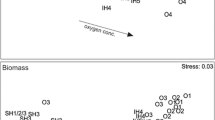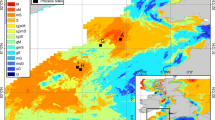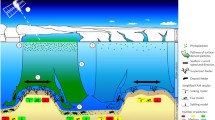Abstract
Seafloor ecosystems play pivotal roles in biogeochemical cycling, but hypoxia (O2 < 2 mg l−1) is changing the way they contribute to ecosystem function on a global scale. A major issue for mitigation of eutrophication-driven hypoxia is the continued release of phosphorus and nitrogen from sediments. Nutrient cycling is affected by sediment characteristics, benthic communities, and oxygen conditions, but the context dependency of these processes in natural ecosystems is poorly known. The Baltic Sea is naturally a low-diversity system, where hypoxia has further decimated the benthic communities. To investigate how oxygen conditions affect the relationship between benthic fauna and nutrient fluxes across the sediment–water interface, we conducted macrofaunal sampling and measurements of benthic oxygen and nutrient fluxes (NO3 −, NO2 −, NH4 +, PO4 3−, SiO4) at 26 sites across the entire north–south salinity gradient of the Baltic Sea (>1200 km). This broad-scale sampling confirmed the strong salinity-driven diversity gradient and large spatial variations in oxygen conditions, which affected the status of the benthic communities. Benthic nutrient fluxes varied several orders of magnitude, both between sea areas and along gradients of hypoxia within areas. DistLM modeling indicated that benthic fauna can affect nutrient cycling, also under hypoxic conditions, with the invasive polychaete Marenzelleria spp. being particularly important. However, as the oxygen content decreases—even slightly—the subsequent changes in the faunal abundance and functional diversity may influence the nature and the rate of fluxes. These results imply that management targets for oxygen concentrations need to be raised to sustain healthy ecosystem functioning and to facilitate the recovery of large degraded sea areas.





Similar content being viewed by others
References
Aller RC, Aller JY. 1998. The effect of biogenic irrigation intensity and solute exchange on diagenetic reaction rates in marine sediments. J Mar Res 56:905–36.
Allgeier JE, Layman CA, Mumby PJ, Rosemond AD. 2015. Biogeochemical implications of biodiversity and community structure across multiple coastal ecosystems. Ecol Monogr 85:117–32.
Anderson MJ, Gorley RN, Clarke KR. 2008. PERMANOVA + for PRIMER. Guide to software and statistical methods. Plymouth: PRIMER-E Ltd.
Berger WH, Smetacek VS, Wefer G. 1989. Ocean productivity and paleoproductivity—an overview. In: Berger WH, Smetacek VS, Wefer G, Eds. Productivity of the ocean: present and past. New York: Wiley. p 1–34.
Bick A, Burckhardt R. 1989. Erstnachweis von Marenzelleria viridis (Polychaeta, Spionidae) für den Ostseeraum, mit einem Bestimmungsschlüssel der Spioniden der Ostsee. Mitteilungen aus dem Zoologischen Museum in Berlin 65:237–47.
Blank M, Laine AO, Jürss K, Bastrop R. 2008. Molecular identification key based on PCR/RFLP for three polychaete sibling species of the genus Marenzelleria, and the species’ current distribution in the Baltic Sea. Helgol Mar Res 62:129–41.
Bonsdorff E, Pearson TH. 1999. Variation in the sublittoral macrozoobenthos of the Baltic Sea along environmental gradients: a functional-group approach. Aust J Ecol 24:312–26.
Braeckman U, Foshtomi MY, Van Gansbeke D, Meysman F, Soetaert K, Vincx M, Vanaverbeke J. 2014. Variable importance of macrofaunal functional biodiversity for biogeochemical cycling in temperate coastal sediments. Ecosystems 17:720–37.
Cardinale BJ, Duffy JE, Gonzalez A, Hooper DU, Perrings C, Venail P, Narwani A, Mace GM, Tilman D, Wardle DA, Kinzig AP, Daily GC, Loreau M, Grace JB, Larigauderie A, Srivastava DS, Naeem S. 2012. Biodiversity loss and its impact on humanity. Nature 486:59–67.
Carstensen J, Conley DJ, Bonsdorff E, Gustafsson BG, Hietanen S, Janas U, Jilbert T, Maximov A, Norkko A, Norkko J, Reed DC, Slomp CP, Timmermann K, Voss M. 2014. Hypoxia in the Baltic Sea: biogeochemical cycles, benthic fauna and management. Ambio 43:26–36.
Chapin FSIII, Walker BH, Hobbs RJ, Hooper DU, Lawton JH, Sala OE, Tilman D. 1997. Biotic control over the functioning of ecosystems. Science 277:500–4.
Clarke KR, Gorley RN. 2006. PRIMER v6: user manual/tutorial. Plymouth: PRIMER-E.
Conley DJ, Björck S, Bonsdorff E, Carstensen J, Destouni G, Gustafsson BG, Hietanen S, Kortekaas M, Kuosa H, Meier HEM, Müller-Karulis B, Nordberg K, Norkko A, Nürnberg G, Pitkänen H, Rabalais NN, Rosenberg R, Savchuk OP, Slomp CP, Voss M, Wulff F, Zillén L. 2009. Hypoxia-related processes in the Baltic Sea. Environ Sci Technol 43:3412–20.
Dayton PK. 1971. Competition, disturbance and community organization: the provision and subsequent utilization of space in a rocky intertidal community. Ecol Monogr 41:351–89.
Diaz RJ, Rosenberg R. 2008. Spreading dead zones and consequences for marine ecosystems. Science 321:926–9.
Dyson KE, Bulling MT, Solan M, Hernandez-Milian G, Raffaelli DG, White PCL, Paterson DM. 2007. Influence of macrofaunal assemblages and environmental heterogeneity on microphytobenthic production in experimental systems. Proc R Soc B 274:2547–54.
Glud RN. 2008. Oxygen dynamics of marine sediments. Mar Biol Res 4:243–89.
Godbold JA, Bulling MT, Solan M. 2011. Habitat structure mediates biodiversity effects on ecosystem properties. Proc R Soc B 278:2510–18.
Godbold JA, Solan M. 2009. Relative importance of biodiversity and the abiotic environment in mediating an ecosystem process. Mar Ecol Prog Ser 396:273–82.
Grall J, Chauvaud L. 2002. Marine eutrophication and benthos: the need for new approaches and concepts. Glob Change Biol 8:813–30.
HELCOM. 2009a. Biodiversity in the Baltic Sea—an integrated thematic assessment on biodiversity and nature conservation in the Baltic. Baltic Sea Environment Proceedings No. 116B.
HELCOM. 2009b. Eutrophication in the Baltic Sea—an integrated thematic assessment of the effects of nutrient enrichment and eutrophication in the Baltic Sea region. Baltic Sea Environment Proceedings No. 115B.
Hewitt JE, Thrush SF, Dayton PD. 2008. Habitat variation, species diversity and ecological functioning in a marine system. J Exp Mar Biol Ecol 366:116–22.
Hiddink JG, Davies TW, Perkins M, Machairopoulou M, Neill SP. 2009. Context dependency of relationships between biodiversity and ecosystem functioning is different for multiple ecosystem functions. Oikos 118:1892–900.
Hillebrand H, Matthiessen B. 2009. Biodiversity in a complex world: consolidation and progress in functional biodiversity research. Ecol Lett 12:1405–19.
Ingall ED, Bustin RM, Van Cappellen P. 1993. Influence of water column anoxia on the burial and preservation of carbon and phosphorus in marine shales. Geochim Cosmochim Acta 57:303–16.
Jäntti H, Hietanen S. 2012. The effects of hypoxia on sediment nitrogen cycling in the Baltic Sea. Ambio 41:161–9.
Jilbert T, Slomp CP, Gustafsson BG, Boer W. 2011. Beyond the Fe-P-redox connection: preferential regeneration of phosphorus from organic matter as a key control on Baltic Sea nutrient cycles. Biogeosciences 8:1699–720.
Josefson AB, Norkko J, Norkko A. 2012. Burial and decomposition of plant pigments in surface sediments of the Baltic Sea—role of oxygen and benthic fauna. Mar Ecol Prog Ser 455:33–49.
Karlson K, Bonsdorff E, Rosenberg R. 2007. The impact of benthic macrofauna for nutrient fluxes from Baltic Sea sediments. Ambio 36:161–7.
Karlson K, Rosenberg R, Bonsdorff E. 2002. Temporal and spatial large-scale effects of eutrophication and oxygen deficiency on benthic fauna in Scandinavian and Baltic waters—a review. Oceanogr Mar Biol Annu Rev 40:427–89.
Kauppi L, Norkko A, Norkko J. 2015. Large-scale species invasion into a low-diversity system: spatial and temporal distribution of the invasive polychaetes Marenzelleria spp. in the Baltic Sea. Biol Invasions 17:2055–74.
Kemp WM, Testa JM, Conley DJ, Gilbert D, Hagy JD. 2009. Temporal responses of coastal hypoxia to nutrient loading and physical controls. Biogeosciences 6:2985–3008.
Larsen TH, Williams NM, Kremen C. 2005. Extinction order and altered community structure rapidly disrupt ecosystem functioning. Ecol Lett 8:538–47.
Levin LA, Boesch DF, Covich A, Dahm C, Erséus C, Ewel KC, Kneib RT, Moldenke A, Palmer MA, Snelgrove P, Strayer D, Weslawski JM. 2001. The function of marine critical transition zones and the importance of sediment biodiversity. Ecosystems 4:430–51.
Levin LA, Ekau W, Gooday AJ, Jorissen F, Middelburg JJ, Naqvi SWA, Neira C, Rabalais NN, Zhang J. 2009. Effects of natural and human-induced hypoxia on coastal benthos. Biogeosciences 6:2063–98.
Levinton J. 1995. Bioturbators as ecosystem engineers: control of the sediment fabric, inter-individual interactions, and material fluxes. In: Jones CG, Lawton JH, Eds. Linking species and ecosystems. New York: Chapman and Hall. p 29–38.
Link H, Piepenburg D, Archambault P. 2013. Are hotspots always hotspots? The relationship between diversity, resource and ecosystem functions in the Arctic. PLoS One 8:e74077.
Loreau M, Naeem S, Inchausti P, Bengtsson J, Grime JP, Hector A, Hooper DU, Huston MA, Raffaelli D, Schmid B, Tilman D, Wardle DA. 2001. Biodiversity and ecosystem functioning: current knowledge and future challenges. Science 294:804–8.
Lundberg C, Jakobsson B-M, Bonsdorff E. 2009. The spreading of eutrophication in the eastern coast of the Gulf of Bothnia, northern Baltic Sea—an analysis in time and space. Estuar Coast Shelf Sci 82:152–60.
Meysman FJR, Middelburg JJ, Heip CHR. 2006. Bioturbation: a fresh look at Darwin’s last idea. Trends Ecol Evol 21:688–95.
Mortimer CH. 1941. The exchange of dissolved substances between mud and water in lakes. J Ecol 29:280–329.
Norkko A, Hewitt JE, Thrush SF, Funnell GA. 2006. Conditional outcomes of facilitation by a habitat-modifying subtidal bivalve. Ecology 87:226–34.
Norkko A, Villnäs A, Norkko J, Valanko S, Pilditch CA. 2013. Size matters: implications of the loss of large individuals for ecosystem function. Sci Rep 3:2646.
Norkko J, Reed DC, Timmermann K, Norkko A, Gustafsson BG, Bonsdorff E, Slomp CP, Carstensen J, Conley DJ. 2012. A welcome can of worms? Hypoxia mitigation by an invasive species. Glob Change Biol 18:422–34.
Pearson TH, Rosenberg R. 1978. Macrobenthic succession in relation to organic enrichment and pollution of the marine environment. Oceanogr Mar Biol Annu Rev 16:229–311.
Polis GA, Holt RD, Menge BA, Winemiller KO. 1996. Time, space, and life history: influences on food webs. In: Polis GA, Winemiller KO, Eds. Food webs: integration of patterns and dynamics. New York: Chapman and Hall. p 435–60.
Quintana CO, Kristensen E, Valdemarsen T. 2013. Impact of the invasive polychaete Marenzelleria viridis on the biogeochemistry of sandy marine sediments. Biogeochemistry 115:95–109.
Rabalais NN, Díaz RJ, Levin LA, Turner RE, Gilbert D, Zhang J. 2010. Dynamics and distribution of natural and human-caused hypoxia. Biogeosciences 7:585–619.
Reed DC, Slomp CP, Gustafsson BG. 2011. Sedimentary phosphorus dynamics and the evolution of bottom water hypoxia: a coupled benthic-pelagic model of a coastal system. Limnol Oceanogr 56:1075–92.
Rhoads DC. 1974. Organism-sediment relations on the muddy sea floor. Oceanogr Mar Biol Annu Rev 12:223–300.
Schiedek D. 1997. Marenzelleria cf. viridis (Polychaeta: Spionidae)—ecophysiological adaptations to a life in the coastal waters of the Baltic Sea. Aquat Ecol 31:199–210.
Slomp CP, Thomson J, de Lange GJ. 2002. Enhanced regeneration of phosphorus during formation of the most recent eastern Mediterranean sapropel (S1). Geochim Cosmochim Acta 66:1171–84.
Snelgrove PVR, Thrush SF, Wall DH, Norkko A. 2014. Real world biodiversity–ecosystem functioning: a seafloor perspective. Trends Ecol Evol 29:398–405.
Solan M, Cardinale BJ, Downing AL, Engelhardt KAM, Ruesink JL, Srivastava DS. 2004. Extinction and ecosystem function in the marine benthos. Science 306:1177–80.
Thrush SF, Hewitt JE, Dayton PD, Coco G, Lohrer AM, Norkko A, Norkko J, Chiantore M. 2009. Forecasting the limits of resilience: integrating empirical research with theory. Proc R Soc B 276:3209–17.
Timmermann K, Norkko J, Janas U, Norkko A, Gustafsson BG, Bonsdorff E. 2012. Modelling macrofaunal biomass in relation to hypoxia and nutrient loading. J Mar Syst 105:60–9.
Tuominen L, Heinänen A, Kuparinen J, Nielsen LP. 1998. Spatial and temporal variability of denitrification in the sediments of the northern Baltic Proper. Mar Ecol Prog Ser 172:13–24.
Vahtera E, Conley DJ, Gustafsson BG, Kuosa H, Pitkänen H, Savchuk OP, Tamminen T, Viitasalo M, Voss M, Wasmund N, Wulff F. 2007. Internal ecosystem feedbacks enhance nitrogen-fixing cyanobacteria blooms and complicate management in the Baltic Sea. Ambio 36:186–94.
Vaquer-Sunyer R, Duarte CM. 2008. Thresholds of hypoxia for marine biodiversity. Proc Natl Acad Sci 105:15452–7.
Villnäs A, Norkko A. 2011. Benthic diversity gradients and shifting baselines: implications for assessing environmental status. Ecol Appl 21:2172–86.
Villnäs A, Norkko A, Norkko J, Lukkari K, Hewitt J. 2012. Impacts of increasing hypoxic disturbance on benthic biodiversity and ecosystem functioning. PLoS One 7:e44920.
Villnäs A, Norkko J, Hietanen S, Josefson AB, Lukkari K, Norkko A. 2013. The role of recurrent disturbances for ecosystem multifunctionality. Ecology 94:2275–87.
Vitousek PM, D’antonio CM, Loope LL, Rejmanek M, Westbrooks R. 1997. Introduced species: a significant component of human-caused global change. N Z J Ecol 21:1–16.
Volkenborn N, Polerecky L, Wethey DS, Woodin SA. 2010. Oscillatory porewater bioadvection in marine sediments induced by hydraulic activities of Arenicola marina. Limnol Oceanogr 55:1231–47.
Wollast R. 1991. The coastal organic carbon cycle: fluxes, sources, and sinks. In: Mantoura RFC, Martin JM, Wollast R, Eds. Ocean margin processes in global change. New York: Wiley. p 365–81.
Woulds C, Cowie GL, Levin LA, Andersson JH, Middelburg JJ, Vandewiele S, Lamont PA, Larkin KE, Gooday AJ, Schumacher S, Whitcraft C, Jeffreys RM, Schwartz M. 2007. Oxygen as a control on seafloor biological communities and their roles in sedimentary carbon cycling. Limnol Oceanogr 52:1698–709.
Yachi S, Loreau M. 1999. Biodiversity and ecosystem productivity in a fluctuating environment: the insurance hypothesis. Proc Natl Acad Sci 96:1463–8.
Acknowledgments
This study was funded by the Academy of Finland (project numbers 114076 and 110999), the BONUS + project HYPER, the DEVOTES project (EU Grant agreement no. 308392), the Walter and Andrée de Nottbeck Foundation (Senior Research Fellowship to JH), the Kone Foundation, and the University of Helsinki (3-year grant to JN). We thank the scientific crew on R/V Aranda for invaluable help with sampling and laboratory analyses (J Bruun, K Hyvärinen, S Hyvärinen, M Jaale, P Jämsen, P Kosloff, I Lastumäki, J Pitkänen, J Rapo, I Remonen, H Söderman, S Toijanaho, P Varmanen, J Ögård) and SF Thrush, A Villnäs, and two reviewers for constructive comments on the manuscript.
Author information
Authors and Affiliations
Corresponding author
Additional information
Author contributions
JN and AN designed the study; JN, JG, AN, and AJ conducted the field sampling; JG conducted laboratory analyses; JH, JN, AN, and JC conducted the numerical analyses; JN, AN, and JH wrote the manuscript; and all authors contributed to revisions.
Electronic supplementary material
Below is the link to the electronic supplementary material.
Rights and permissions
About this article
Cite this article
Norkko, J., Gammal, J., Hewitt, J.E. et al. Seafloor Ecosystem Function Relationships: In Situ Patterns of Change Across Gradients of Increasing Hypoxic Stress. Ecosystems 18, 1424–1439 (2015). https://doi.org/10.1007/s10021-015-9909-2
Received:
Accepted:
Published:
Issue Date:
DOI: https://doi.org/10.1007/s10021-015-9909-2




